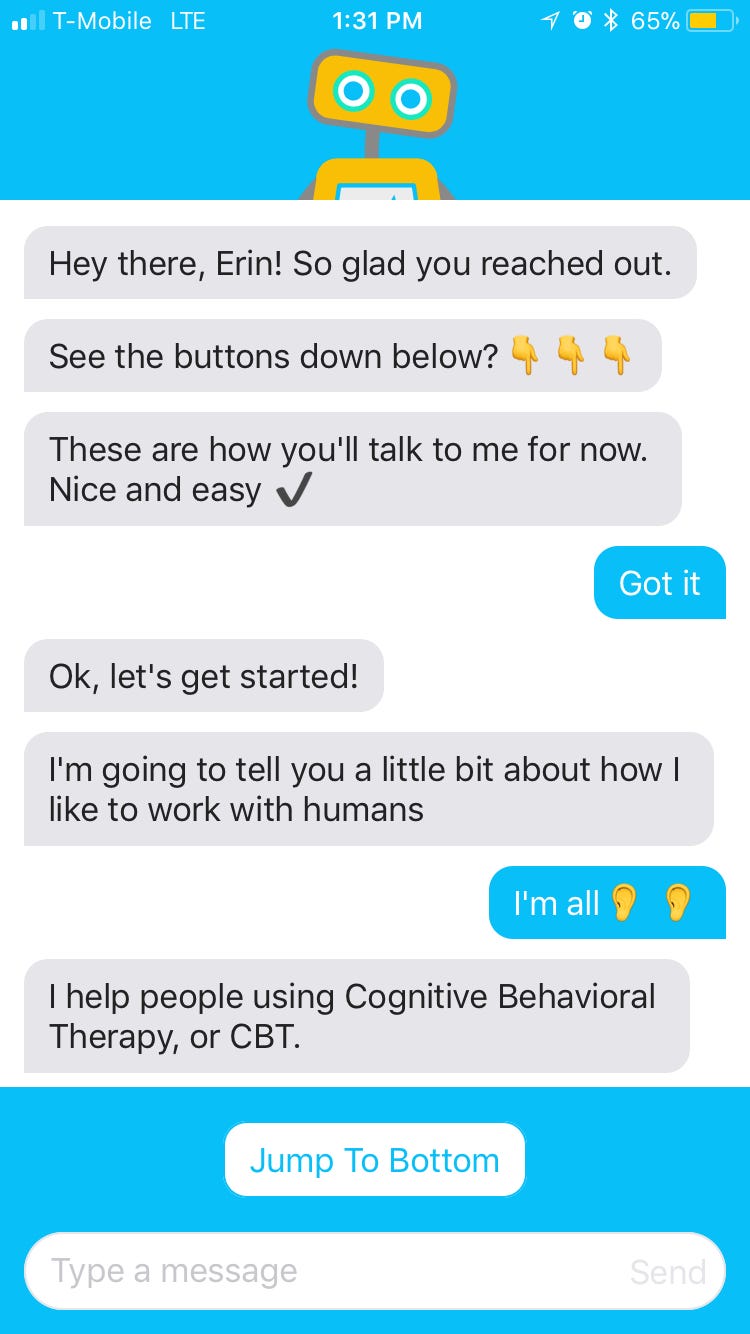Since the creation of the Turing Test in the 1950s, researchers and inventors have been trying to develop machines that can hold realistic conversations with humans. Until recently, the attempts at satisfying this challenge had no real practical use and played no role in the lives of most individuals. With the advent of virtual personal and customer assistants (e.g., Amazon Alexa, Apple Siri, and Google Now), this changed rapidly. Now, millions of individuals interact with tiny robots every day that help them with a variety tasks (e.g., making purchasing decisions or finding out how to make a margarita).
Following the trend of developing practical conversational artificial intelligence (AI), companies have begun to create systems that focus not on the ability to assist individuals with mundane everyday needs but rather to provide health services that would otherwise be much more difficult to access. In particular, psychologists and computer scientists have been working together to produce versions of this technology that play some of the therapeutic conversational roles that are typically saved for human psychotherapists (e.g., offering empathic responses and providing instructions on how to apply well-tested treatments like cognitive behavioral therapy).
 Sample conversation with Woebot, a mental health chatbot trained in CBT. Photo credit to Erin Brodwin from Insider News
Sample conversation with Woebot, a mental health chatbot trained in CBT. Photo credit to Erin Brodwin from Insider News
The Benefits
Robot therapists remove many barriers that may otherwise have prevented some individuals from seeking treatment or applying it effectively. More specifically, these technologies are:
- Cheaper (Woebot is free)
- Less time consuming (no need to travel anywhere to receive the therapy)
- Available on-demand
- Able to provide users with access to treatments without having to navigate complex mental health systems
- Well-suited for keeping users engaged and accountable by providing daily reminders and suggestions
 An example of the kinds of notifications that Woebot sends to users to keep them engaged with the app and their treatments
An example of the kinds of notifications that Woebot sends to users to keep them engaged with the app and their treatments
Collectively, these benefits stand to persuade a significant number of individuals to seek treatment who otherwise would not have had access to it or simply would have felt that the trouble of accessing treatment wasn’t worth the potential benefits. At a time where symptoms of anxiety and depression are on the rise (from one in 10 U.S adults in 2019 to four in 10 in 2020, according to a study conducted by KFF), novel technological solutions that increase the accessibility of mental health care are of significant value.
Limitations And The Future Of Robot Therapists
Though therapeutic conversational AI are a good addition to the small variety of services available to individuals suffering from anxiety and depression, they are, in their current state, far from perfect solutions for every person and every mental health condition.
For one thing, current robot therapists are obviously not as smart as human therapists. In fact, they are rather limited in what they can do. What this means in practice is that the robot therapists of today may misunderstand bits of dialogue or not know what the appropriate response is (e.g., in cases where a user expresses symptoms of a condition that it is not equipped to deal with). Sometimes, they will tell users that this is the case, but it is not safe to assume that they will always do so.
In a critical examination of “embodied artificial intelligence in psychiatry, psychology, and psychotherapy” lead by Dr. Amelia Fiske from the Technical University of Munich, researchers suggested that in order to address this problem, “embodied AI should remain under the supervision of trained mental health professionals.” This may be a necessary solution for the near future. Over time however, AI will continue to improve. As a result, robot therapists’ psychotherapeutic abilities may eventually outstrip those of the human therapists who may soon be supervising them. When (and if) this happens, supervision will be harder to accomplish, but perhaps less necessary.
A further problem, which is common to the use of both human and robot therapists, is that they must rely on the patient’s own analysis of their anxiety and depression levels which may not always be accurate, though therapists may not have to rely solely on user reports in the near future. As Wellable mentions in a post on stress detection and management technologies, companies are beginning to develop ways of measuring stress levels that rely on biometric data (e.g., blood pressure, heart rate, and even brain waves), which newer versions of therapeutic conversational AI could make use of when evaluating the state of the user.
Takeaway For Employers
Anxiety and depression are detrimental to happiness, health, productivity and engagement. Though treatments exist to deal with these ailments, not everyone has access to them, and even among those who do, they aren’t all sufficiently motivated seek out available help. Robot therapists may change this problem going forward. Employers should keep an eye on this developing technology while remaining hopeful but appropriately critical of what it can accomplish today and what it may accomplish in the future.












